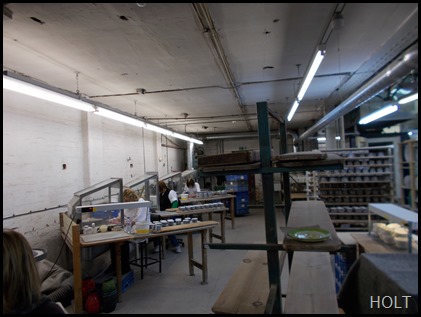As you may know we have been here since Monday getting a few jobs done. We were pulled out of the water about mid day and the first thing they did was check the stern gear for play, no problem, this was followed by a high pressure wash down to get all the crud and lose paint off.

One of the jobs was a new rudder cup, on out boat like most Narrowboats the bottom of the rudders shaft sits in a metal cup welded to the skeg. Over the last couple of years the play in this has increased and I had no idea how thin the sides of the cup were getting.
Over the last couple of years the play in this has increased and I had no idea how thin the sides of the cup were getting.
In reality I need not have been worried as the original cup had a bronze sleeve in it and this still had material left let alone the steel outer housing so it would probably lasted another 20 or 30 years before failing. Normally you can lift the rudder out of the cup but the rudder shaft had not mover it the top bearing for the last 17 years and it didn’t intend to start now, so the complete bearing housing was unbolted. This allowed the rudder to be lifted but not high enough to clear the cup as the upper edge of the rudder blade hit the under side of the hull. The only answer was to cut the cup off the skeg and then slide it sideways until it could be dropped off. A new steel cup was made up and welded to the skeg, hopefully this will be the last time we have to do this job. While working on the rudder I noticed that where the rudder strikes the base plate it had worn two notches, only in the wear edge but they were about to start on the weld, so a small sacrificial piece of metal was welded to each side. 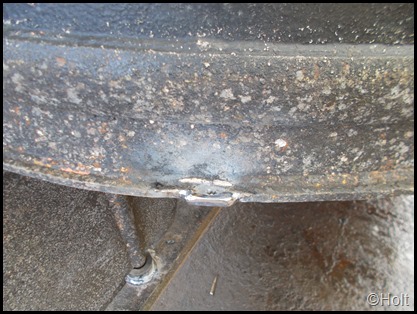
The yard also suggested that I have an anode fitted in the Bowthruster tube, normally they put one each side but our tube is very short compared with most Narrowboats as the bow is finer. This anode is mounted on bolts as there is no danger of it getting hit, so two suitable bolts were welded into the bottom of the tube. Once the hull was dry it was give a coat of blacking around the water line and left overnight to dry. All the blacking has been applied by brush so far.
Once the hull was dry it was give a coat of blacking around the water line and left overnight to dry. All the blacking has been applied by brush so far. This morning another coat of black was applied to the sides of the hull from base plate to gunwale not forgetting the bowthruster .tube.
This morning another coat of black was applied to the sides of the hull from base plate to gunwale not forgetting the bowthruster .tube. The new anode was removed for this operation and will be refitted when work is complete.
The new anode was removed for this operation and will be refitted when work is complete. 
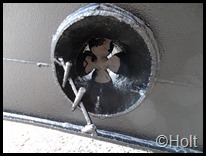
As you can see the boat is in a polytunnel and we have a stairway at each end for getting on and off with.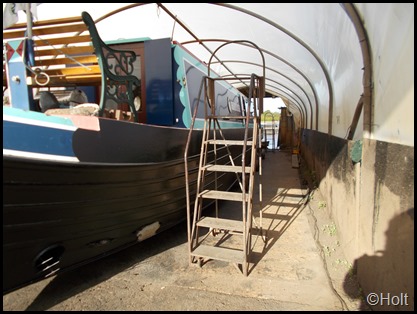 As the hull is looking a lot smarter I thought i would splash our and fit a new bow fender as well. Lots of people fit these with chains but I tie mine on so that if it catches on the top of a gate it wont hang the boat up. It will be a few weeks before it beds in and sits nicely.
As the hull is looking a lot smarter I thought i would splash our and fit a new bow fender as well. Lots of people fit these with chains but I tie mine on so that if it catches on the top of a gate it wont hang the boat up. It will be a few weeks before it beds in and sits nicely.
The down side of being in a polytunnel is that we cant run the stove so we have to keep going down The Plough at Huddlesford for diner each evening, Last night we went by car but this morning we walked down in the sun and had a coffee. The sun was nice but the breeze decidedly cool. The weather improved late this afternoon so this evening we walked down for a meal. We have found the food very good and they have a beer that I have not tried before called Golden Sheep, its brewed by the Black Sheep Brewery. I expect we will have to walk down again tomorrow evening as well.
Today is Wednesday and just after lunch the last coat of black went on, this one is from base plate to rubbing strake, so above the rubbing strake has one coat, this is the area a lot of people gloss and spend the other 51 weeks worrying about. From the rubbing strake down to below the water line there are 3 coats, this is the area that suffers the most abuse and corrosion and below this band to the base plate is 2 coats. Most of it was put on by brush and only flat areas were rollered with the top coat so it was well worked in to all the nocks and crannies.
There are some interesting craft in the yard and I do wonder if some of them will ever see the water again, some with steel work like lace and so old wooden boats with rotten bottoms. 
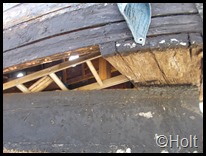
Round the corner some one has built a tug using the back end of a BCN boat as a bow and putting a new bum on it. I guess the plate under the propeller is to stop it sucking the mud and rubbish up off the bottom. With no flow coming from below I wonder how it effects the handling.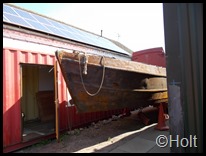
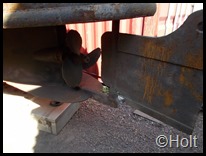
One boat I thought interesting, the boat looks nothing special but it has this unusual rudder arrangement, I bet its a dream going backwards. Talking to a chap working on it, its a stock boat they are doing up to sell.
This afternoon I took our car back to King’s Bromley and the chap from the boat we use to moor next to kindly gave me a lift back, so now when we are back in the water Diana will not have to take it back and walk the tow path to meet me.
Another little job I took care of today was adjusting the tappets. I had attempted this some time ago, it has to be done with the engine cold, I knew they were all to wide but I had not come across this type of adjustment before. There is no locknut like ones I have done in the past, these just are just like a bold and I couldn’t move then with a ring spanner. I had to use a 7/16 socket and large T bar to move them, last time I tried I was worried about snapping them off, but today I just used more force and it worked. It will be interesting to see if I notice a difference in the way it runs, I just hope it starts tomorrow.
Thursday
About half eleven there was activity around the boat and the guiding poles were put back in the trolley. Then the anode was bolted in the bow thruster tube and the guard replaced. Check the weed hatch cover was replaced and we were ready for the off, just as soon as they could get the tractor driver and his machine. I refitted the tiller, the towing machine connected, stair ways removed and we were off. As soon as we clear of the poly tunnel I started the engine, thankfully it started first shot. They had to take the towing machine, Its like a very heavy big JCB forklift truck well into the water before we floated free. 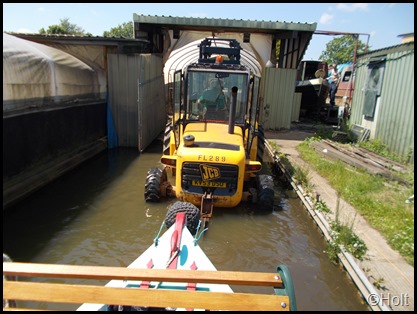 We are unusually deep at the bows drawing two foot as we are ballasted almost level. Most boats run light at the front, some only drawing a few inches. I needed to go back almost against the far towpath before driving the stern round, the chaps at the boat yard have a metal loop arrangement they put over the bow stud to control the bow as you leave the trailer. You can see the guide poles on the trailer ahead of us.
We are unusually deep at the bows drawing two foot as we are ballasted almost level. Most boats run light at the front, some only drawing a few inches. I needed to go back almost against the far towpath before driving the stern round, the chaps at the boat yard have a metal loop arrangement they put over the bow stud to control the bow as you leave the trailer. You can see the guide poles on the trailer ahead of us.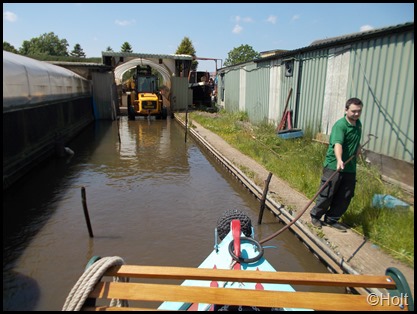 Then round to the service quay to pump out the toilet tank, a check under the back deck to make sure the weed hatch was sealed and we were almost ready for the off, just a trip to the office to pay the bill. By now there was already another boat up on the slip awaiting their attention.
Then round to the service quay to pump out the toilet tank, a check under the back deck to make sure the weed hatch was sealed and we were almost ready for the off, just a trip to the office to pay the bill. By now there was already another boat up on the slip awaiting their attention.


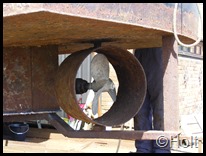

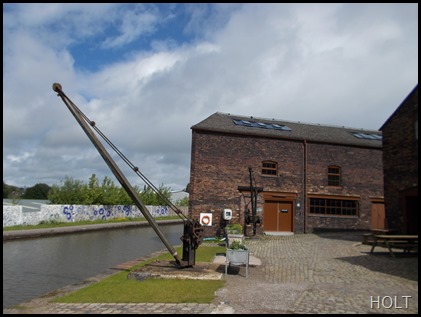
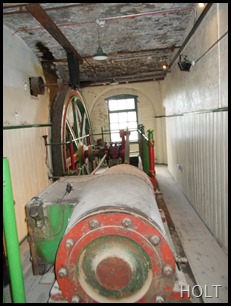
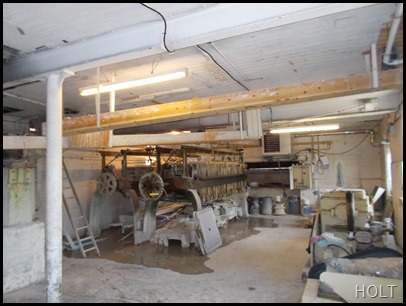



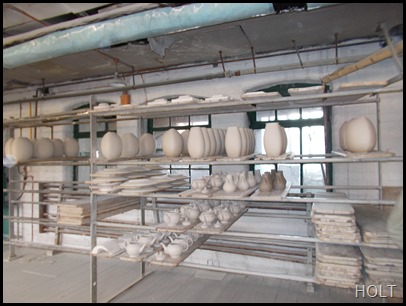

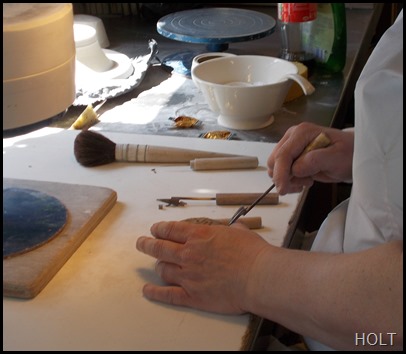


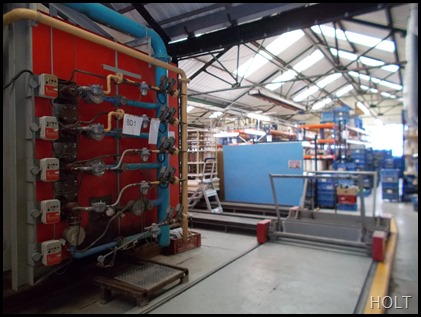

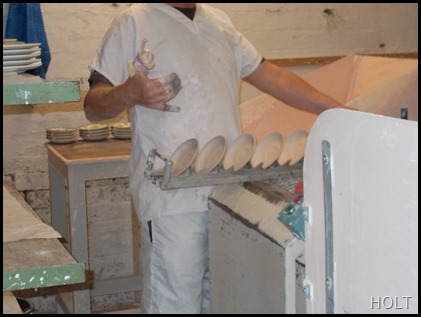
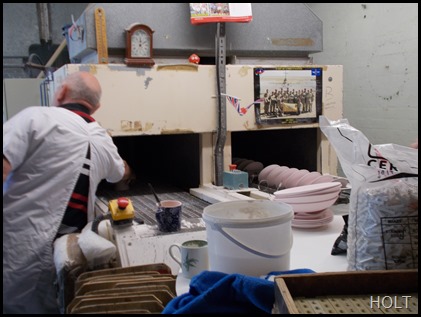
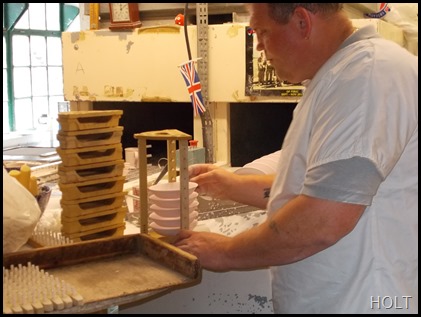
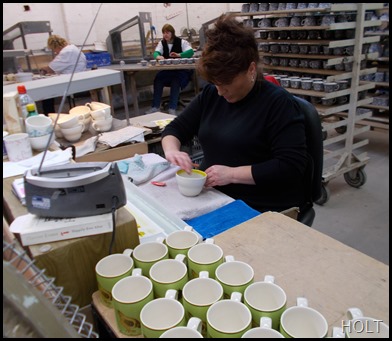
 down on top to spread the clay to just the right thickness. You can see the green plates behind him in the dryer.
down on top to spread the clay to just the right thickness. You can see the green plates behind him in the dryer.
